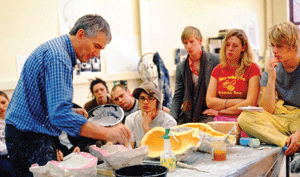Talent and tenacity
How can creative graduates maximise their chances of securing paid work post-university? Zoë Ellsmore takes a look

With only one-third of this year’s graduates expecting to find work, according to a recent survey from High Fliers, times are tough for arts graduates. The creative industries may well have been growing at twice the rate of the UK economy but they are also more competitive than ever. Those new to the sector can struggle to find paid employment. Yet research into career paths has revealed creative graduates to be flexible and resourceful, and therefore well placed to ride out and even take advantage of uncertain economic times. Like many arts institutions across the UK, University of the Arts London (which is comprised of six arts colleges across the capital) is running a series of initiatives to help arts graduates get that essential first step on the career ladder.
KNOW HOW TO NETWORK
As more employers use word of mouth to recruit staff, networking skills are becoming ever more important to job hunters. Graduates need to make themselves known to employers through attending private views or trade events, following the right people on Twitter and connecting with them on LinkedIn, or directly approaching their ideal employer for industry advice. Internships that allow the graduate to experience meaningful, paid work that benefit both employer and intern are another route. The trick is to secure a placement that is useful but not exploitative, challenging but not impossible. Opportunities can be found in far-flung places; University of the Arts London students and graduates have interned at advertising agencies in India, design studios in Italy and have even set up their own ethical design project at an orphanage in Vietnam.
BUILD BUSINESS SAVVY
Nearly half of creative graduates freelance in the early stage of their career. Graduates need to be realistic and flexible; they may not find their ideal job immediately but may be able to secure a related role or land project work. As well as equipping them with vital experience and industry contacts, this can lead to further opportunities or a flourishing career as a freelancer. Ninety-two per cent of University of the Arts London graduates were in work 12 months after graduating and of those 18% were self employed (2008). Around a quarter of creative graduates start their own business and for those with a unique idea and business know-how this can be one of the most rewarding career choices. Through free financial, legal and business support, our Enterprise Centre for the Creative Arts has helped graduates successfully launch fashion labels, design agencies and interior design businesses, as well as helping freelancers to develop their careers.
“Graduates can improve their situation by getting lots of work experience; doing lots of networking – employers are recruiting through word of mouth rather than through formal adverts; and by making sure their CVs and portfolios are very strong,” advises Julia Yates, Head of Creative Careers at University of the Arts London. When undertaking internships, graduates should ensure that it is beneficial to them as well as the employer – interns can expect training, dedicated supervision, flexible hours and travel costs.
With the creative sector contributing £60bn a year to the British economy the new generation of arts graduates will be vital to economic recovery. Armed with the right approach and business savvy, creative graduates can not just survive, but thrive, during uncertain times.
CASE STUDIES
TAKE THE INITIATIVE
Sarah Rowles graduated this year and has given herself a head start. Before completing her Art Foundation at Camberwell College of Arts in 2007, she had already undertaken nine internships at galleries and art fairs. In the second year of her BA Art Practice at Goldsmiths she set up Q-Art London, a forum for art students and graduates. This experience and a desire to demystify the art world led her to publish the book ‘12 Gallerists: 20 Questions’, sold in the Tate and Institute of Contemporary Arts. She now hopes to expand Q-Art’s 2,500 members and to work with university departments charged with widening participation in higher education.
CONSIDER YOUR OPTIONS
Since graduating in 2007, Tom Smith has successfully carved himself a career as a practising artist and lecturer, although it got off to a slow start. He says: “My prayers were not answered during the final show. I wasn’t inundated with interest from major galleries and the work did not sell.” He took a year out to develop his work and completed an MA at the Royal College of Art, after which he was offered a tutorship at Kingston University. Tom now divides his time between the studio and teaching jobs. His BA at Central Saint Martins introduced him to a variety of practices and people, and he says: “My tutors were very supportive in helping me with references and shows years after I left. The connections I made have kept me going with work…and (my) education forms the basis for my practice.” Tom is currently exhibiting at Lisbon City Museum and has a show opening in London this month.
STAY CONFIDENT
For others who have graduated this summer, the future is more uncertain. Graphic designer Tom Niblett has been freelancing since completing his course to gain experience as a professional practitioner, as well as undertaking non-paying projects. He is confident in the grounding his course has given him, especially as it allowed him “to make necessary connections throughout [my] time studying there. The course is structured to provide opportunities to network with industry professionals weekly and also compete for live briefs.” Tom is now setting up a graphic design studio with a fellow Chelsea College of Art and Design graduate.
Join the Discussion
You must be logged in to post a comment.